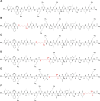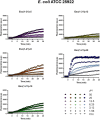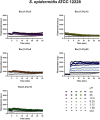Modulating Antimicrobial Activity and Structure of the Peptide Esc(1-21) via Site-Specific Isopeptide Bond Formation
- PMID: 40769954
- PMCID: PMC12328261
- DOI: 10.1002/psc.70048
Modulating Antimicrobial Activity and Structure of the Peptide Esc(1-21) via Site-Specific Isopeptide Bond Formation
Abstract
Antimicrobial peptides (AMPs) represent valid alternatives to conventional antibiotics primarily due to their mechanism of action, which consists of cytoplasmic membrane disruption. However, their clinical application is often limited by cytotoxicity at high concentrations and low intrinsic biostability. To address these limitations, various biochemical approaches have been explored. In recent years, the frog-skin derived AMP Esc(1-21) has been extensively characterized for its potent antimicrobial activity, especially against Gram-negative bacteria, both in vitro and in vivo. In this study, we designed and synthesized novel Esc(1-21) analogs in which a single isopeptide bond was introduced in place of a conventional peptide bond at specific positions within the sequence. The resulting five analogs were evaluated for their (i) chemical and structural properties, (ii) resistance to proteolytic degradation, (iii) antimicrobial and antibiofilm activities, (iv) hemolytic and cytotoxic effects, and (v) ability to perturb bacterial cytoplasmic membranes. Among these, Esc(1-21)ε20 showed the most promising features, maintaining antimicrobial and antibiofilm activities comparable to those of the parent peptide while exhibiting lower cytotoxicity towards eukaryotic cells at higher concentrations and greater resistance to enzymatic degradation. These findings highlight Esc(1-21)ε20 as an attractive lead candidate for the development of new antibiotic therapeutics.
© 2025 The Author(s). Journal of Peptide Science published by European Peptide Society and John Wiley & Sons Ltd.
Conflict of interest statement
The authors declare no conflicts of interest.
Figures







Similar articles
-
Impact of lipidation site on the activity of α-helical antimicrobial peptides.Bioorg Chem. 2024 Dec;153:107821. doi: 10.1016/j.bioorg.2024.107821. Epub 2024 Sep 13. Bioorg Chem. 2024. PMID: 39293303
-
The antibacterial activity and therapeutic potential of the amphibian-derived peptide TB_KKG6K.mSphere. 2025 Jun 25;10(6):e0101624. doi: 10.1128/msphere.01016-24. Epub 2025 May 19. mSphere. 2025. PMID: 40387366 Free PMC article.
-
Fragments of cathelicidins PMAP-36 and BMAP-27 and their D-enantiomers: Effects of all D substitutions on structure, protease resistance and antimicrobial properties.Bioorg Chem. 2025 Aug;163:108715. doi: 10.1016/j.bioorg.2025.108715. Epub 2025 Jun 30. Bioorg Chem. 2025. PMID: 40609280
-
AI-Driven Antimicrobial Peptide Discovery: Mining and Generation.Acc Chem Res. 2025 Jun 17;58(12):1831-1846. doi: 10.1021/acs.accounts.0c00594. Epub 2025 Jun 3. Acc Chem Res. 2025. PMID: 40459283 Free PMC article. Review.
-
The Black Book of Psychotropic Dosing and Monitoring.Psychopharmacol Bull. 2024 Jul 8;54(3):8-59. Psychopharmacol Bull. 2024. PMID: 38993656 Free PMC article. Review.
References
-
- Fathi F., Alizadeh B., Tabarzad M. V., and Tabarzad M., “Important Structural Features of Antimicrobial Peptides Towards Specific Activity: Trends in the Development of Efficient Therapeutics,” Bioorganic Chemistry 149 (2024): 107524. - PubMed
-
- Carneri F., Troiano C., Giaquinto G., Roversi D., Franzyk H., and Stella L., “Water‐Membrane Partition and the Mutant Selection Window of Antimicrobial Peptides: Insights From Liposome Studies,” Journal of Colloid and Interface Science 683, no. Pt 1 (2025): 1078–1086. - PubMed
MeSH terms
Substances
Grants and funding
- PRIN2022-2022XFFTH5/Ministero dell'Istruzione, dell'Università e della Ricerca
- PRIN 2020833Y75_005/Ministero dell'Istruzione, dell'Università e della Ricerca
- RG124190CBD34B9D/Sapienza Università di Roma
- ECS 00000024/European Union - NextGenerationEU
- Dr. Barry Sherman Institute for Medicinal Chemistry
LinkOut - more resources
Full Text Sources
Medical
